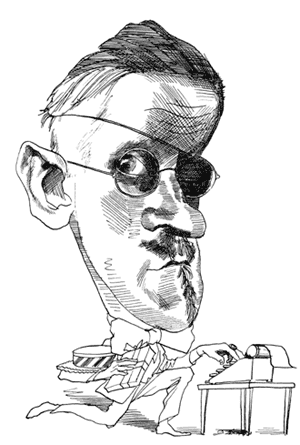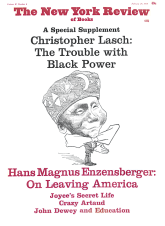“Who? A pale face surrounded by heavy odorous furs. Her movements are shy and nervous. She uses quizzing-glasses. Yes: a brief syllable. A brief laugh. A brief beat of the eyelids.”
Who? Ellmann does not give her name in his Introduction or his Notes. This means, I take it, that we are being asked to read Giacomo Joyce not as autobiography but as fiction, as a story about one Giacomo, a language teacher, and his Platonic affair with an anonymous Dark Lady, his pupil. In that case, the only relevant answers to the question “Who?” are those given in the text: she is young, Jewish, rich, frail, shy, has a very great admiration for her maestro inglese, but finally retires into frigid hostility. The time is about 1911-13, the place Trieste. And who is Giacomo? A poet in his early thirties, erudite and oblique, irlandese italianato, incarnate Lucifer in rebellion against a libidinous and epileptic lord and giver of life, a Renaissance soul in Prufrock-coat, writing his Portrait of the Artist as a Young- Middle-Aged Adulterer in a sequence of highly mannered prose poems, some of great beauty.
But it is impossible to sustain this purist view of the book, even as an aesthetic exercise, since Ellmann has already given the lady’s name, with a full explanation of the circumstances, in his notable biography of Joyce (1959). He also quoted most of the text of Giacomo Joyce there: it is therefore not quite correct for this edition to be hailed, as it was recently in the press, as the first publication of a recently discovered work. It is better to look at it as a private journal, not intended for publication, reflecting Joyce’s obsessions with adultery, dark oriental beauties, underclothes, laced boots, theology, Elizabethan music, and so on. As Ellmann shows in his excellent commentary Joyce composed this set of “epiphanies” with great care, and later used some of the best sentences in the Portrait and Ulysses. These reappear in Stephen’s meditations, e.g., “Belluomo rises from the bed of his wife’s lover’s wife: the busy housewife is astir, sloe-eyed, a saucer of acetic acid in her hand….” and in Bloom’s “She follows her mother with ungainly grace, the mare leading her filly foal.” Giacomo Joyce became split into Stephen and Bloom, the lady was combined with others and transmuted into Martha Clifford, Gerty MacDowell, and even Molly. But if Giacomo Joyce was used as a quarry for the novels, it is also significant that it contains at least one deliberate reworking of earlier writing, in the strange vision of the Good Friday Mass in Paris:
…Tawny gloom in the vast gargoyled church. It is cold as on that morning: quia frigus erat. Upon the steps of the high altar, naked as the body of the Lord, the ministers lie prostrate in weak prayer. The voice of an unseen reader rises, intoning the lesson from Hosea. Haec dicit Dominus: intribulatione sua mane consurgent ad me. Venite et revertamur ad Dominum…. She stands beside me, pale and chill, clothed with the shadows of the sindark nave, her thin elbow at my arm.
This is based on the description of the Good Friday Mass in Stephen Hero: “the altar naked…the priests lying prostrate on the altar steps…the Reader”; these words and the Latin prayer are too close to be coincidental. (I owe this observation to Dr. Arnold Goldman, who has made a special study of this motif of the Good Friday Mass in his book The Joyce Paradox.) Joyce husbanded his obsessive themes from manuscript to manuscript until they were ready to take their final form in the printed book. Thus the Paris Mass extract ends with Christ’s words, “Weep not for me, O daughters of Jerusalem!” which also reappear in Ulysses; and on the last page he writes about his final rejection by the lady, “Non hunc sed Barabbam!” In Exiles, written about the same time and on many of the same themes, Richard Rowan speaks of “the disciple who will betray him.” This shows that already Joyce had begun to identify the Richard-Giacomo-Stephen- Artist figure with the figure of Christ; and it points forward to the close identification in Ulysses of Stephen’s adventures with the Vita Christi, which is still one of the least known and most extraordinary parts of the novel.
Joyce copied his sequence of prose-poems, about 2500 words in all, onto both sides of eight large leaves of a notebook. He did not give it a title, and another hand wrote “Giacomo Joyce” on a label and stuck it on the cover. In this edition the sixteen pages are reproduced photographically, the first two and last two in the actual size, the others reduced. This is preceded by a line-by-line transcription of the text, which seems to me wholly accurate (though p. 8, 1.4 is wrongly transcribed in the notes). It makes a handsome little volume, and the only complaint I have is that the facsimile leaves are not folded properly: everything else, typography, layout, and binding, are admirable.
Advertisement
Thanks to Ellmann’s Introduction and Notes, everything in Giacomo Joyce makes pretty clear sense—with one exception. On page 15, the next to last of the notebook, there is a passage of some 200 words which remains highly obscure. It breaks the sequence, which here deals with the end of the affair, and changes the time and place abruptly.
A soft crumpled peagreen cover drapes the lounge. A narrow Parisian room. The hairdresser lay here but now. I kissed her stocking and the hem of her rust-black dusty skirt. It is the other. She. Gogarty came yesterday to be introduced. Ulysses is the reason. Symbol of the intellectual conscience…. Ireland then? And the husband? Pacing the corridor in list shoes or playing chess against himself. Why are we left here? The hairdresser lay here but now, clutching my head between her knobby knees…. Intellectual symbol of my race. Listen! The plunging gloom has fallen. Listen!
—I am not convinced that such activities of the mind or body can be called unhealthy—
She speaks. A weak voice from beyond the cold stars. Voice of wisdom. Say on! O, say again, making me wise! This voice I never heard.
She coils towards me along the crumpled $$$ I cannot move or speak. Coiling approach of starborn flesh. Adultery of wisdom. No. I will go. I will.
—Jim, love!—
Soft sucking lips kiss my left armpit: a coiling kiss on myriad veins. I burn! I crumple like a burning leaf! From my right armpit a fang of flame leaps out. A starry snake has kissed me: a cold nightsnake. I am lost!
—Nora!—
I have quoted this passage in full because it raises so many questions. Is it set in Paris? Who is the hairdresser? Why Gogarty and Ulysses? Who is the husband? And the various “she”s? The last is certainly Nora Joyce; and the last part seems to describe Joyce returning to Nora after some escapade or other. But the earlier “she”s seem to refer to some other person or persons: perhaps “the weak voice from beyond the cold stars” is the Trieste lady’s discussing the Portrait, heard in memory, but the rest seems to have little connection with her. Ellmann’s explanation is that this is a “dream about Ulysses,” and he uses it to date the whole of Giacomo Joyce. Joyce could hardly have had such a dream, he argues, “before 1914, the year that, as he always said afterward, the book [Ulysses] took shape in his mind.” Ellmann also notes that on this page “the clotted images are reinforced by dense handwriting and absence of pause.”
With all the respect due to the Editor, I will make a guess that the handwriting gives the clue: it is, in my opinion, quite different, not only in size but in shape of letters, from that in the rest of the notebook. Elsewhere the handwriting is all pretty much the same, even in the other paragraph on page 15; in this passage it looks like the hand of Joyce’s late thirties. If my guess is correct, the passage could have been written after 1920, when Joyce had moved to Paris and published parts of Ulysses; he could then have inserted it into the blank space on page 15, one of the many blanks in the notebook. We can then drop 1914 as the date for completing Giacomo and put the rest of the work back to 1912-13, where on all the other evidence it belongs. Nor is the passage just a “dream”: it is probably an “epiphany” about a later affair of Joyce’s, possibly not Platonic this time; it may even refer to his obsession with another Jewish girl, Marthe Fleishmann, in Zurich during 1918-19. Whoever she was, Joyce drew a parallel with the Trieste lady, whose voice and presence he recalled with exquisite regret. Having mentioned Shelley’s Beatrice Cenci in the notebook, he now adapted the Ode to the West Wind. “I burn! I crumple like a burning leaf!” is based, I think, on “Oh, lift me as a wave, a leaf, a cloud! I fall upon the thorns of life! I bleed!” After a second summer, it was again autumn. Again he had proved the truth of what he had written on the last page of the notebook: “Youth has an end: the end is here. It will never be. You know that well. What then? Write it, damn you, write it! What else are you good for?”
This Issue
February 29, 1968




